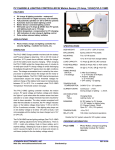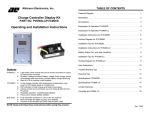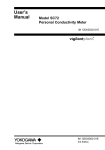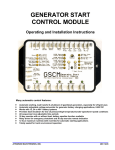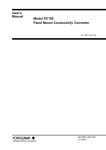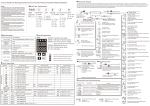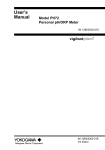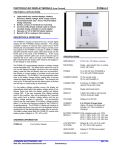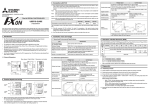Download PVLC-40 - Atkinson Electronics Inc
Transcript
40 AMP, 12/24V IN-LINE PV CHARGE & LIGHTING CONTROLLER PVLC-40 FEATURES v v v v v v v v v v v PV charge & lighting controller - waterproof Micro-controller for digital accuracy and reliability Fully automatic operation on 12V or 24V DC systems Automatic dusk and dawn lighting control All night, or adjustable time-off for area lighting with pre-dawn lighting for signs Will handle up to 40 Amps @ 28VDC from PV panels and lighting loads up to 40 Amps Built-in low voltage disconnect, max load 40 Amps Built-in temperature compensation for PV charging LED indication of solar charge & lighting control Selectable operation for sealed/flooded batteries Pulse action reduces battery sulfation APPLICATIONS v SPECIFICATIONS Photo Voltaic charge and lighting controller for: area lighting and large roadside signs. OPERATION The PVLC-40 charge controller monitors both the battery and PV panel voltage to determine: 12V or 24V DC mode of operation, if PV panels have sufficient voltage for charge, and if the battery bank requires charging. When charging the PVLC-40 cycles the charge relay every 4 minutes to reverify open circuit PV charge voltage to avoid discharging the batteries through the PV panels when low light conditions occur. The charge re-connection time is varied by the microprocessor to optimally reduce the charge rate for nearly or fully charged batteries. The PVLC-40 internal temperature compensation adjusts the charge threshold voltages for optimum charge of the battery bank based on temperatures between 08C to 458C. For a complete chart refer to the PVCM-10 or PVCM-20 data sheets. The PVLC-40 lighting controller monitors PV panel voltage and initiates the “light-on” cycle when a dusk voltage threshold has been reached and energizes the lighting relay. It remains energized until either the time selection is reached, the PV voltage indicates dawn, or the battery voltage drops below 11.0V (or 22.0V) DC for 5 continuous minutes. If the lighting relay drops out on low battery voltage or is below 12V (24V) at dusk, it will not re-energize until the battery has been charged up to 12V (or 24V) DC. If a “sign” time range (7,8,9) is selected, the lighting relay will turn on for the number of hours selected after dark and turn on again two hours before dawn the next morning. The PVLC-40 must operate through one full 24 hour day/night cycle after power up before the lighting relay will turn on 2 hours before dawn. Selecting (6) “all night” on the timing switch causes the lights to remain on dusk to dawn (subject to the low battery voltage cutout). If the timing switch selection is “zero” (0) the PVLC-40 will operate as a PV charge controller with low voltage disconnect. The lighting relay will immediately turn on and will turn off when battery voltage falls below 11.0V or 22.0V DC. The dusk to dawn lighting functions are bypassed in the Low Voltage Disconnect mode. SIZE/WEIGHT: ENCLOSURE: MOUNTING: POWER: LOAD CAPACITY: CONNECTION: 3.3"W x 5.5"L x 1.65"H Epoxy potted in PVC plastic Two 1/2" #8 screws 8 to 30 V DC from storage battery 40 Amps @ 28V DC (NO contact) 1/4" Bolt Connectors Ring Connector Molex #BCL814PL 1/4" Spade Battery Negative (-) FLOODED BATTERY On @ 12.7V DC, Off @ 14.2V DC PV CHARGE: @ Room temperature 20-258C SEALED BATTERY PV CHARGE: TIMING RANGE SWITCHES: (10 Settings) TEMPERATURE COMPENSATION: 0.040V/8C for 12V systems CURRENT DRAW: (Values same for 12V & 24V) LED INDICATION: Red Yellow MINIMUMS: TEMPERATURE: Continuous - [ 5.3mA During charge or lighting 60mA Nominal, Higher for LVD Mode “0" Charging Mode Lighting Cycle ‘on’ 9.5V DC battery for PV charge 11V DC battery for lighting relay PV Charge Current - 80mA Open PV - 16V (12V system) -30 to 758C RELAY LIFE: 100 million mechanical operations Double the 12V system values for 24V system values ORDERING INFORMATION PVLC-40 - ATKINSON ELECTRONICS, INC. Web Site: www.atkinsonelectronics.com *Blue Jumper Clipped* On @ 12.4V DC, Off @ 13.9V DC 6 After Dusk Settings (2 Hrs to All Night) 3 Sign Settings (2 Hrs Before Dawn) 1 Low Voltage Disconnect Option See next page for adjustments Photo-Voltaic charge & Lighting Controller module. Relay contacts rated for 40 Amps @ 28V DC. REV 12/03 Distributed by: 40 AMP, 12/24V IN-LINE PV CHARGE & LIGHTING CONTROLLER PVLC-40 PVLC-40 TEMPERATURE THRESHOLDS PVLC-40 SWITCH - LIGHTING ADJUSTMENTS Below 08C On @ 13.3V, Off @ 15.0V Between 0-58C On @ 13.3V, Off @ 14.8V Between 5-108C On @ 13.1V, Off @ 14.6V Between 10-158C On @ 12.9V, Off @ 14.4V Between 15-308C On @ 12.7V, Off @ 14.2V Between 30-358C On @ 12.7V, Off @ 14.0V Between 35-408C On @ 12.6V, Off @ 13.8V Between 40-458C On @ 12.6V, Off @ 13.6V Above 458C On @ 12.7V, Off @ 14.2V *Gel Cell Batteries - 0.3V Lower Pos. Pos. Pos. Pos. Pos. Pos. Pos. Pos. Pos. Pos. “0" “1" “2" “3" “4" “5" “6" “7" “8" “9" - Low Voltage Disconnect On for 2 hrs after dusk On for 3 hrs after dusk On for 4 hrs after dusk On for 6 hrs after dusk On for 8 hrs after dusk On from dusk to dawn On for 6 hrs after dusk, 2 hrs before dawn On for 4 hrs after dusk, 2 hrs before dawn On for 2 hrs after dusk, 2 hrs before dawn INSTALLATION AND STARTUP INSTRUCTIONS 1. 2. 3. 4. 5. 6. 7. Connect the PV panel and lighting load negative wires to the negative battery post. Connect the PVLC-40 B(+) terminal to the Battery positive post (user supplied wire and 50 Amp fuse) and the PV panel + wire to the PVLC-40 PV terminal. Wait to connect the PVLC-40 B(-) terminal to battery negative post. Adjust the desired time range on the switch per PVLC-15 switch lighting options. Now connect the PVLC-40 B(-) to the battery negative post to power up the PVLC-40. Verify that the initial battery voltage is greater than 11V or 22V, and PV voltage is greater than 14V or 28V. Twelve seconds after power up, the charge relay (red LED) will click the number of times per the switch position with “0" being 10. If the switch did not get set to the desired position, disconnect the PVLC-40’s B(-) negative wire and reset switch. Reconnect the PVLC-40's B(-) negative wire and verify the desired timing range. If the open circuit PV voltage is above 16V (32V) and the battery voltage is below the “turn on” threshold, then the PV charge relay will energize, charging the battery. Every 4 minutes the PV relay will drop-out momentarily to test for the presence of adequate PV charge sunlight. To test the lighting function, disconnect the PV wire from terminal, after a short delay( 5-7 seconds) the lighting relay (yellow LED) should energize the lighting load. Now disconnect the PVLC-40 B(-) wire and reconnect the PV wire to PV terminal, and then reconnect the black wire. Mount the PVLC-40 securely with screws and coat the switch with silicone to insure that the entire module is waterproof. Waterproof the electrical connections with silicone or grease. Note: The PVLC-40 is powered by either the battery or PV voltage, which ever is greater. The charge relay is only powered from the PV voltage. If there is insufficient PV voltage when powering up the PVLC-40, the charge relay will only click once after a 12 second delay. If there is sufficient PV voltage( >16V/32V), then after a 12 second delay the PV relay will click out the switch position with “0" being 10 clicks, it then checks the Battery voltage, if its below the “turn on” threshold, the charge relay energizes after a delay of 5 seconds. If battery voltage is above the turn on threshold, then it will wait until it drops below the threshold. If the switch setting is in the zero (0) position, both relays will energize. WIRING DIAGRAM - LIGHTING CONTROL APPLICATION The PVLC-40 charges the battery from the solar PV panel during the day. At dusk the PVLC-40 senses the low PV panel voltage and turns on the light for the selected time period. The light will automatically turn off at dawn. In the Sign option, the PVLC-40 also turns on the light two hours before dawn. ATKINSON ELECTRONICS, INC. Web Site: www.atkinsonelectronics.com REV 12/03 Distributed by: 40 AMP, 12/24V IN-LINE PV CHARGE & LIGHTING CONTROLLER PVLC-40 TROUBLESHOOTING TIPS Problem Solution - Module doesn’t click on and there is sunlight on the PV panels. Verify that the battery voltage is less than 12.75V (or 25.5V on a 24V DC system) and that the open PV voltage is greater than 16V or (32V). If both conditions are met, wait for a 4 minute delay period. Problem Solution - Module clicks every several minutes. This is the normal operating sequence. Problem Solution - Module charges for a few seconds then shuts off for 4 minutes. The Batteries are fully charged and the charge current was at maximum output. It may also mean that the Batteries have a poor connection or a bad cell with high internal resistance. Problem Solution - Module switches on for 1 or 2 minutes and then is off for a much longer period of time. This is also normal if the battery is at or nearly fully charged and the PV charge current is at or near maximum. Problem - Solution - The battery load has been left on and the storage battery has discharged below 8V DC. The PV system is not charging when the load is turned off. The PVLC-40 needs at least 9.5V DC from the battery to operate properly. Place the panel in direct sunlight and jumper the battery and PV terminals for a few minutes, thus bypassing the charge controller allowing the battery voltage to rise to at least 9.5V DC. Disconnecting the jumper will allow the PVLC-40 to charge the battery up to normal levels. Problem Solution - The module is set for lighting control and at dusk fails to turn on lights. The PVLC-40 checks the battery voltage at dusk to see if batteries are greater than 12V (or 24V) DC, sufficient to run lights. If not, lock out lighting relay until the solar panels have charged battery above 12V DC (24V DC). LOW VOLTAGE DISCONNECT APPLICATION When using the PVLC-40 in a low voltage disconnect application rather than lighting control, set the switch to the “zero” (0) position. Such applications include solar powered instrumentation or a telecommunications site where sensitive electronic equipment could be damaged by low battery voltage. The startup instructions may be followed, the only difference is the load relay will turn on and stay on except for a low battery voltage condition. The presence of PV voltage has no effect on the LVD operation. A sister product, PVLVD-15, provides more flexibility in low voltage disconnect solar PV applications. ATKINSON ELECTRONICS, INC. Web Site: www.atkinsonelectronics.com REV 12/03 Distributed by:



